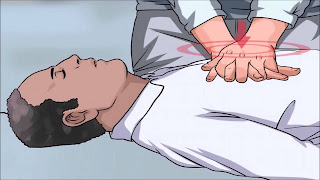At
the end of a mountain road in Austria during the summer of 2003, I waited for a
boat with my family on a dock at a large lake. Suddenly I saw a man fall to the side walk. His skin had turned that ashen blue color, and it was clear to me
that he was in cardiac arrest. There was a crowd of more than 75 persons just
standing and looking at him.
I knew what to do when there was no detectable
pulse or breathing. Cardio-Pulmonary Resuscitation (CPR) chest compressions
were started immediately. His skin color returned to nearly normal. After a few
minutes, a single bystander came up and said they knew how to do breaths. At that time, recommendations were for intermittent breathing as well as chest compressions. The stricken person made it alive to the EMS vehicle that took
nearly 30 minutes to arrive. While I do not know the eventual outcome, I do know
he was successfully resuscitated using an Automated External Defibrillator
(AED). Furthermore with the quick application of CPR, he likely had a full
recovery. Unfortunately, from the crowd response at that time, there were not
enough people trained to act in this emergency situation where seconds really
count.

No comments:
Post a Comment